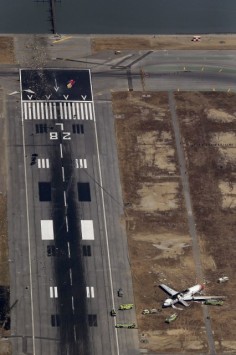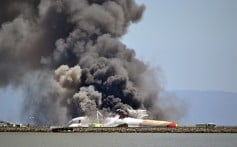
Asiana crew tried to abort landing before San Francisco crash as China mourns 2 girls killed
Two Chinese schoolgirls killed, 180 passengers hurt as Shanghai flight crashes in San Francisco
US officials yesterday began investigating the crash of an Asiana Airlines Boeing 777 carrying mostly Chinese passengers that killed two teenage girls and injured more than 180 people.
The jet, which started its journey in Shanghai and picked up passengers in Seoul, crashed and burst into flames on Saturday as it landed short of the runway at San Francisco International Airport.
The girls killed were Ye Mengyuan and Wang Linjia, 16-year-old middle school students in eastern Zhejiang province. They were seated at the rear of the plane and their bodies were found on the tarmac. More than 100 people walked away unhurt.
Video: Asiana Airlines passenger jet crashes in San Francisco
On Sunday, the San Francisco fire department said an emergency vehicle rushing to the scene of the crash may have run over one of the victims. “One of the deceased did have injuries consistent with those of having been run over by a vehicle,” fire department spokeswoman Mindy Talmadge said. “Many agencies were on the field yesterday.”
San Francisco’s medical examiner is now conducting an autopsy to determine the cause of the girl’s death, Talmadge said.

The US National Transportation Safety Board (NTSB) said on Sunday that the Boeing 777 was travelling “significantly below” its intended speed and its crew tried to abort the landing just seconds before it hit the seawall in front of the runway.
Information collected from the plane’s cockpit voice recorder and flight data recorder indicated that there were no signs of trouble until seven seconds before impact, when the crew tried to accelerate, NTSB chairwoman Deborah Hersman said at a news conference at the airport.
A stall warning sounded four seconds before impact, and the crew tried to abort the landing and initiate what’s known as a ”go around” maneuver just 1.5 seconds before crashing, Hersman said.
“Air speed was significantly below the target airspeed,” she said. Hersman said it was too early to speculate on the cause of the crash.
Asked whether the information reviewed by the NTSB showed pilot error in the crash, Hersman did not answer directly.
“What I will tell you is that the NTSB conducts very thorough investigations. We will not reach a determination of probable cause in the first few days that we’re on an accident scene,” she told reporters.
The Federal Aviation Administration was also investigating.
Witnesses said the tail of the plane appeared to hit the approach area of the runway that juts into San Francisco Bay. One said the plane appeared to be coming in too low and too fast. The tail came off and the aircraft appeared to bounce violently, scattering a trail of debris.
Aboard the plane were 141 Chinese, 77 South Koreans, 61 Americans, a Japanese citizen, three Indians, three Canadians, a French citizen, a Vietnamese national, three of unidentified nationality, and 16 crew members, Asiana said.
At least 70 Chinese pupils and teachers were heading to summer camps, education authorities in China said.

Six people remained in critical condition at San Francisco General Hospital on Sunday, including one girl, a hospital spokeswoman said, and 13 others were in less serious condition. Stanford Hospital said late on Saturday that three people were in critical condition and 10 in serious condition there.
At least five people were still being treated at other area hospitals on Sunday morning.
Some of the injured at San Francisco General suffered spinal fractures, including paralysis, and others sustained head trauma and abdominal injuries, according to Margaret Knudson, chief of surgery at the hospital.
At least two patients also suffered “severe road rash suggesting they were dragged”, Knudson said. The injured patients who were able to talk said they were all sitting in the back of the plane, Knudson said.
Survivor Benjamin Levy told a local NBC station he believed the Asiana plane had been coming in too low. "I know the airport pretty well, so I realised the guy was a bit too low, too fast, and somehow he was not going to hit the runway on time … He put some gas and tried to go up again," he said.
"But it was too late, so we hit the runway pretty bad, and then we started going up in the air again, and then landed again, pretty hard."
A senior Asiana official said the plane was being flown by Lee Jeong-min, a veteran pilot who has spent his career with the airline. He was one of four pilots on the plane who rotated on two-person shifts during the 10-hour flight, the official said.
Additional reporting by Agence France-Presse

